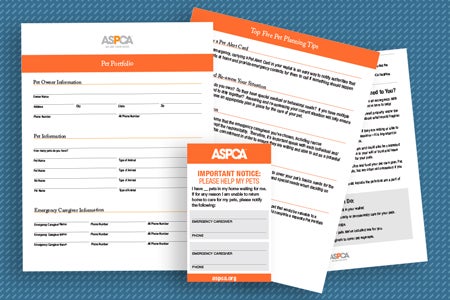
Making a Plan for Your Pet

STEP 1: Create your own pet plan or order our free pet planning packet to help you ensure your pets are always safe, even if you are no longer able to care for them.
Items to Include in Your Pet Plan
1. Pet Alert Card
This card, which you can carry in your wallet, will alert authorities that you have a pet at home. It will also list two emergency contacts who can be notified if something happens to you.
2. Emergency Contact Sheet
If friends, family members or emergency services enter your home, having a clearly visible Emergency Contact Sheet ensures that all of your pets are accounted for and that someone can be contacted immediately to care for them.
3. Pet Portfolio
This document should contain pertinent information about your pet that would be valuable to a potential guardian and/or caregiver in your absence. Even if you don’t have a plan in place for the future care of your pet, this information is vital to helping your pet find a new home faster.
Some examples of information to include are:
- Habits
- Food preferences
- Medical conditions and medications taken
- Veterinary information and records
- Behavior around other pets/people/children
Your Pet Portfolio should be kept in a safe but accessible place with your other important papers. Copies should be distributed to all parties in your pet’s circle of care.
STEP 2: Select Caregivers
Choose who you would want to care for your animals if you were no longer able. The person who would step in during an emergency does not have to be the person who would take your animals permanently. Often, a neighbor or friend could step in to check on your pets if you are hospitalized, for example.
Don’t assume! Check in with your chosen caregivers periodically to ensure they are still willing and able to care for your pets.
If you are an owner of more than two pets, it may not always be realistic for a single person to care for all of your animals. It is therefore extremely important for you to plan ahead, particularly if you want them to remain together.
If you cannot find a caregiver, consider becoming familiar and active with your local humane society or other rescue groups operating in your area. Often, local animal welfare organizations will be willing to help place an animal if they have sufficient notice that a person lives alone or has no one to care for a pet if something happens to them. There are also several pet retirement homes sponsored by schools for veterinary medicine and others that are privately operated. Sanctuaries or retirement homes may be a more suitable option for equines and exotic animals, which can live longer and be more expensive than companion animals.
Please avoid instructions for the euthanasia of adoptable animals. There is someone who can love your pet as much as you do!
STEP 3: Funding
Although it is not necessary to leave any money for the care of your pet, we recommend considering a gift to cover your pets’ future costs to ease the burden on a future caregiver. You can leave money in your will or other assets (bank accounts, retirement accounts, life insurance, etc.) to a caregiver in addition to making an informal agreement with that caregiver. Estimate the amount of money you spend on your pets, including medical needs, each year and consider your pets’ life expectancy when calculating how much to leave to your caregiver.
STEP 4: Consider Formal Options
Although an informal arrangement is enough for most pet parents, you may wish to consider a more formal, legal pet plan.
1. Wills
It is possible to include a provision for the care of a pet in your will, and this can be a good way to get money to your chosen caregivers. However, the ASPCA recommends this approach only in conjunction with an informal plan with your chosen caregivers. It can take time for your will to be probated and the will could be challenged in court. Any delay in administering your estate could spell trouble for your pet. Unlike a trust arrangement for the care of a pet, there is no continuing obligation for the executor under a will to see to the well-being of the pet once the administration of an estate is complete. The integrity and moral commitment of the caregiver will be your only assurance that the pet’s care will continue.
2. Pet Trusts
A pet trust can be a good option for complicated or expensive pets, for example, pets with medical needs, pets that need to stay together, or equines and exotics. Not only do horses and exotic animals tend to live longer than companion animals, but they are more expensive to care for and require special living environments.
See our pet trust primer for more information on pet trusts.
3. Other options:
Some uncommon formal options you may consider include:
- A lifetime trust, with any remaining funds going to your caregiver upon your death or reverting to your estate;
- A limited power of attorney, which could authorize someone to make decisions for your pet during your lifetime but would expire at your death; or
- A letter of instruction, which could be included with your overall estate plan to give detail about your pet plan, but is generally not legally binding.
STEP 5: Disaster Preparedness
Create a disaster preparedness plan for your pets by reading more on our disaster preparedness page.

